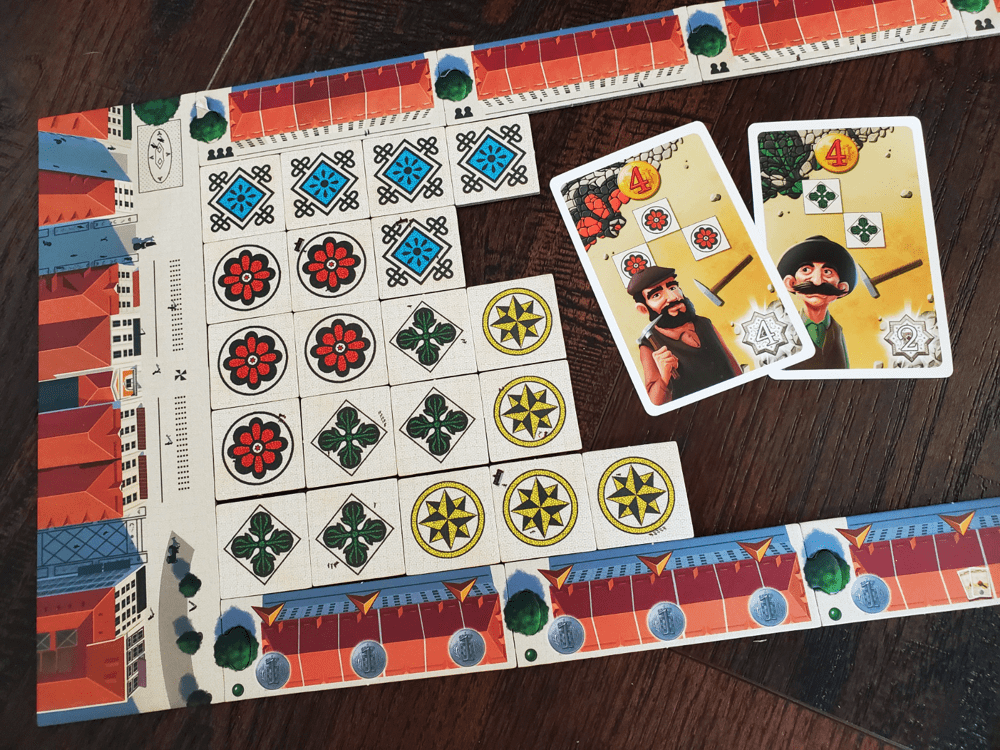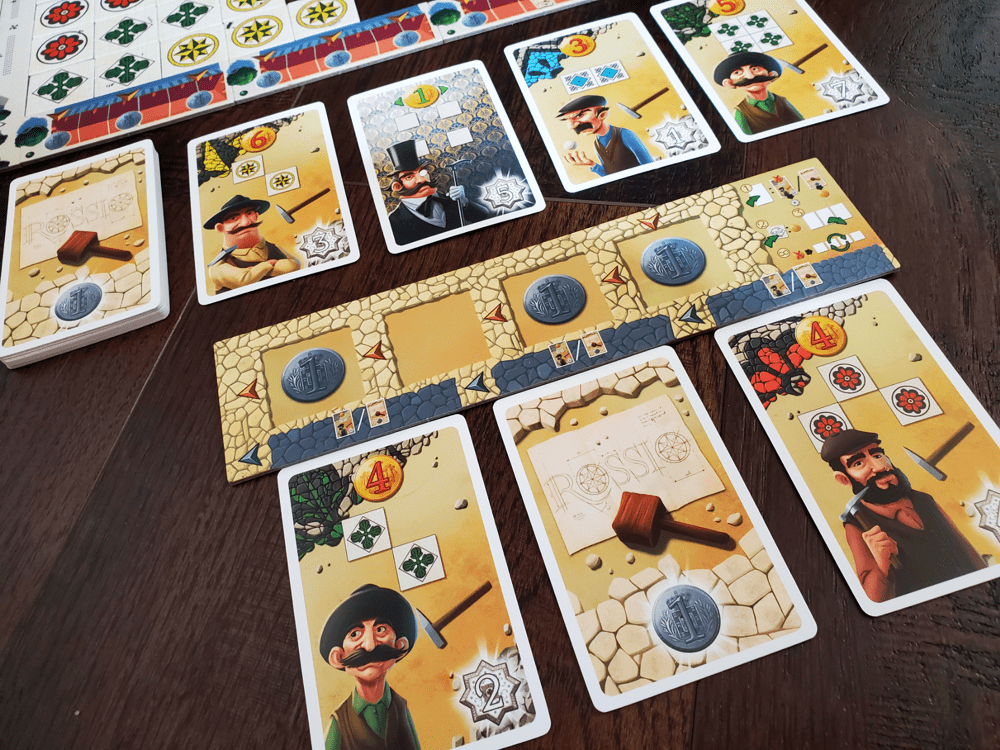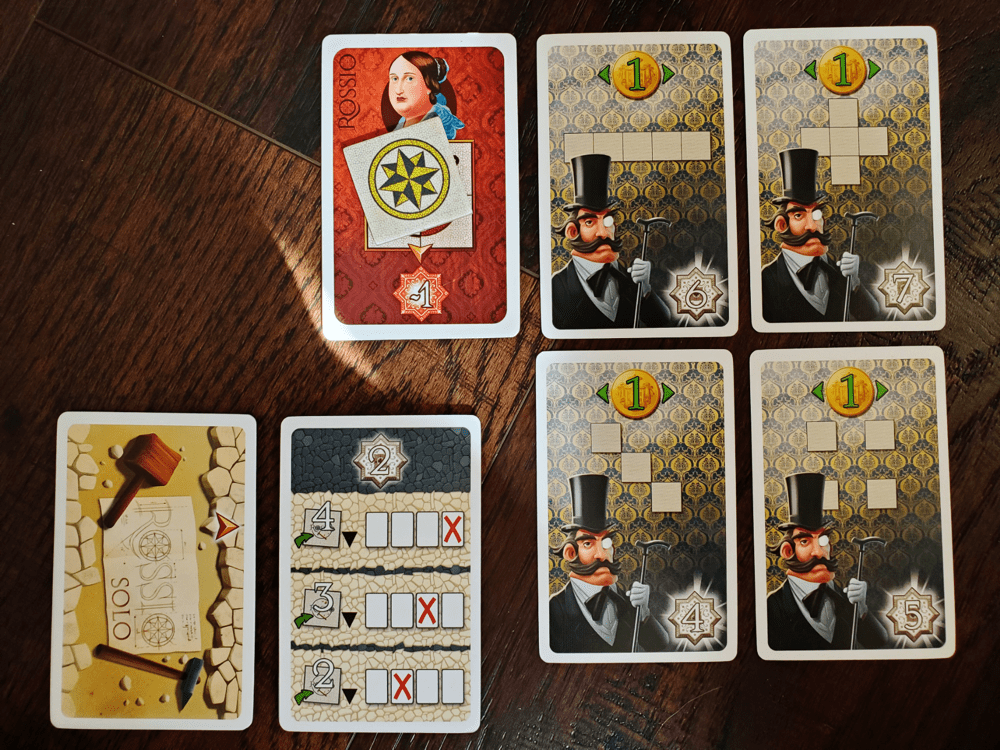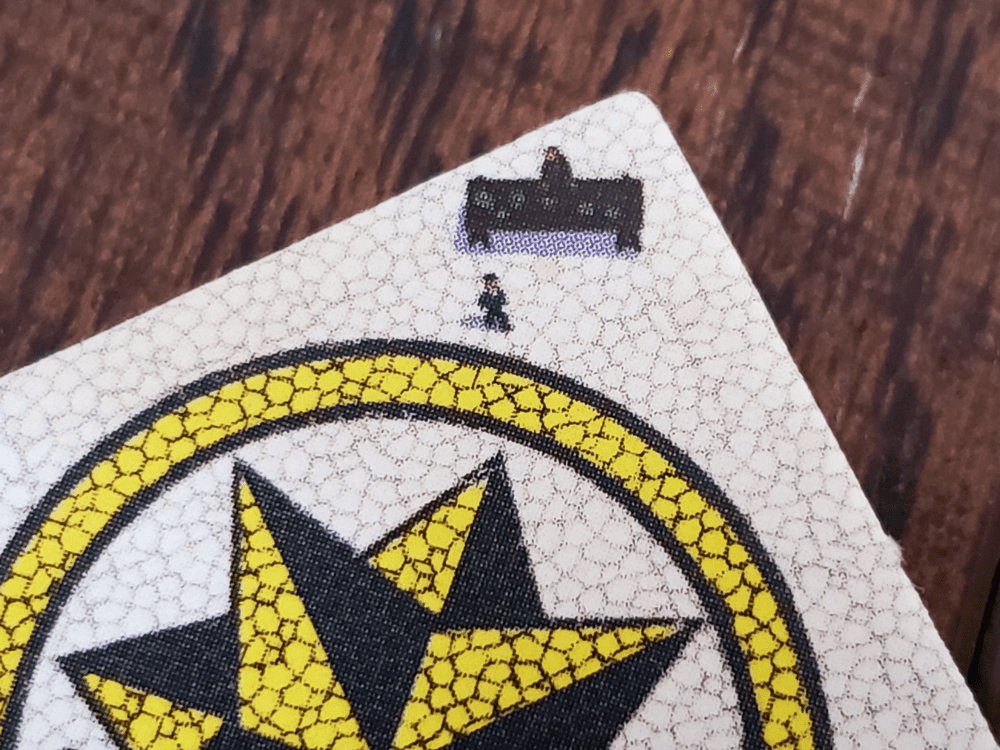Prior to my recent exploration of games from Portuguese publisher Pythagoras, I was not at all familiar with Rossio Square. But as is often the case, a bit of time in a board game leads to a bit of time on the internet. Now the famously tiled square is on the list of places I would love to visit if ever I find myself across the ocean—even if just to wander in the footsteps of the many heteronyms of Fernando Pessoa.
Rossio is a 2020 release from Pythagoras and designer Orlando Sá (Pessoa). This tile-laying, pattern-building endeavor takes place during the reign of Pedro V who commissioned the paving of a square in front of the D. Maria II Theater. Players take up the role of stonemasons, working in the traditional mosaic style known as Calçada Portuguesa, competing to establish beautiful layouts and capitalize on recognized patterns across the square.
Square one
Rossio plays out sort of like building a jigsaw puzzle where all the pieces are square. Setup involves establishing the interlocking borders of the puzzle—overhead illustrations of the buildings around Rossio Square—to a size based on the number of players. Each player receives a small board that holds four pattern tiles plus a few cards.

Each turn includes three steps. First is laying a card from the hand to the rightmost of the three slots below the player board, sliding any previously played cards to the left. If a card is pushed beyond the three slots, it is discarded and will not activate. Cards can be laid either face down for free, which will grant a single coin, or face up for a cost, which will score point tokens based on the number of times the indicated pattern appears in the Square (counting each tile only once per card). Once in place, the current set of cards activates.
Second, players have the opportunity to lay up to four tiles into the Square. The tile patterns come in four varieties—red, blue, yellow, and green. To place a tile into the Square, it must be placed orthogonally adjacent on at least two sides to either another tile or the border. As the rules are worded, the Square must cascade out from the starting side—the far corners are not considered valid plays until the entire construction catches up. In order to continue laying tiles, the previous tile must be touching a matching color on at least one side. At any time, for a cost of one coin, two adjacent tiles can change places to keep the turn going.

If the laid tiles complete a column, the player gains one of three indicated bonuses: collect a coin, draw two cards and discard two, or collect the 3-point token that comes with the final tile of the game. A player also gains up to three coins for laying multiple tiles.
Third, players draw a card and tiles from the market to replenish. Four cards are always visible, but the available cards are determined by the number of tiles played. Four tiles means a choice of any card, while a single tile restricts the “choice” to the card furthest away from the deck. Tiles are drawn from face-down piles.

Play continues until the final tile is laid, at which point the active player gains the 3-point token and every other player carries out the first step of one more turn to gain last-ditch points from cards in play before the final score is revealed.
There are two modules to enhance play. The four Nobles cards introduce a bit of flexibility when they enter play. First, rather than paying for a Noble, the Noble grants a coin to every other player when it enters the scene. These cards then specify a pattern layout, but not a color, which means they can be applied to multiple colors in a single turn—quite valuable, indeed.
The D. Maria II card adds a scoring wrinkle by either increasing or decreasing the value of a particular tile color. Depending on the side played, the tile on the card will either increase or decrease each valid pattern by one point. Players are able to spend one coin during their tile placement to exchange the tile on the card with one from their board. This little card has immediate and deeply felt implications, as it can be used to slight another player’s upcoming turn on the decrease side or attempt future rewards on the gain side.

It’s hip to be square
Rossio has a subdued charm. The colors of the buildings and the tiles pop against the stock background of boardgame beige—not a shiny pop, mind you, but a pop nonetheless. As the game progresses, it is really satisfying to watch the cascading tiles fill out the Square. What at first looks like specks of dirt on the tiles are actually tiny ant-like people moving about their business on the ground below. I appreciate the dedication to providing a bird’s eye view. And though the finished Square contains 45/60/75 tiles in the 2/3/4 player game, there really is no trouble eyeballing every last pattern combo.
Everything in the game itself is easy to read and language-independent. The rulebook is thorough, multi-lingual, and includes abundant and meticulously labeled examples. From a production standpoint, Rossio is fitting. I have some concerns that the jigsaw connectors for the border pieces might start to peel in time, but they are certainly sturdy enough. If I were to add one component (and I believe I will), it would be a bag for the tile draw—making face-down stacks out of the 96 tiles is tedious.

The star mechanism is the continual progression of three cards in front of each player. Knowing each card will last three turns is the source of all the decision space in the game. Playing four tiles for maximum flexibility in card selection becomes critical. Making sure the coins are in hand to play the right card face-up at the right moment makes all the difference. Trying to create patterns that match within the allotted card’s timeline adds stress as coins disappear in the name of rearranging tiles on the player board. The blend of ideas in play is satisfying.
The very first turn card will always be played face down because every player begins destitute. But the remainder of that first turn is the start of jockeying for position to send out four tiles for three coins while laying the groundwork for a banger of an affordable card play in the next turn. The fact that it never feels good to play a card face-down tells me there is a friendly tension and a desire to get things done hovering over the Square.
With every player’s tiles and card progression in sight, tile placement is just interactive enough. It’s possible to cut off another player’s efforts in the Square while servicing your own through a couple of shrewdly placed tiles. I don’t think anyone will shout or rage over a turn in Rossio, but you could definitely earn a cold shoulder. Overall it’s a rather nice brand of competition.
The solo mode introduces ROSS as an opponent. ROSS doesn’t collect coins, but he does bend the rules for tile placement according to the information in his deck, which can be arranged to create a range of difficulties. Each card displays three options, and the back of the card atop his deck indicates which choice he will employ. He gathers points relentlessly, adding pressure to the player to get more tiles out more often. It is a duel rather than a beat-your-best-score effort, which is always nice.
Rossio is not flashy, but it’s fundamentally good. The mechanisms are sturdy and the decisions are interesting. It’s not an award-winner, but it’s the type of game that I could see folks latching onto and playing for a while, especially if they pick up a nice burlap bag of some sort to make the setup more breezy.
When my case of games arrived from Portugal in the fall of 2022, it even included a mug with one of the helpers from the cards staring me in the face. He instantly became a favorite among our kiddos, and it’s nice to think the experience with this game might include that extra bit of flavor. Even if you can’t get your hands on a mug, I think it’s worth a play.












Add Comment